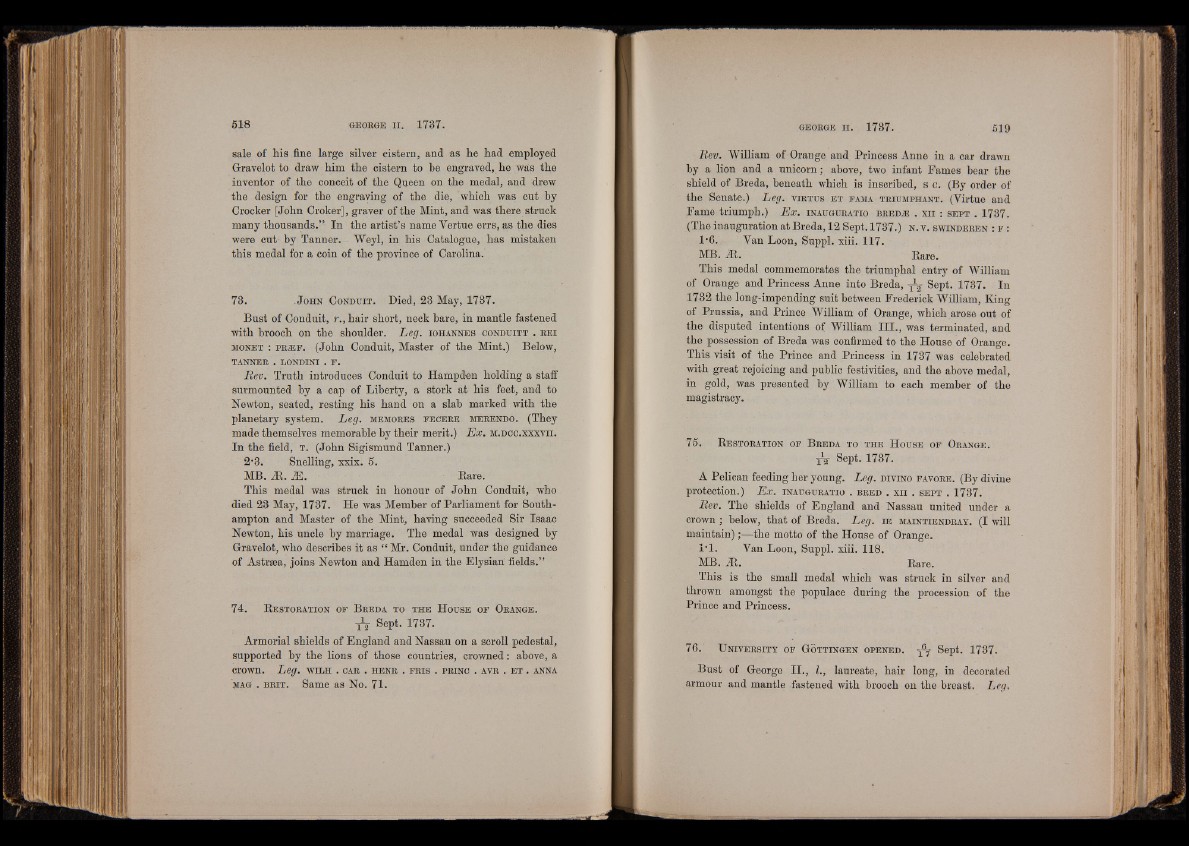
sale of his fine large silver cistern, and as he had employed
Gravelot to draw him the cistern to be engraved, he was the
inventor of the conceit of the Queen on the medal, and drew
the design for the engraving of the die, which was cut by
Crocker [John Croker], graver of the Mint, and was there struck
many thousands.” In the artist’s name Vertue errs, as the dies
were cut by Tanner. Weyl, in his Catalogue, has mistaken
this medal for a coin of the province of Carolina.
73. J o h n C o n d u it . Died, 23 May, 1737.
Bust of Conduit, r., hair short, neck bare, in mantle fastened
with brooch on the shoulder. Leg. i o h a n n e s c o n d u i t t . r e i
m o n e t : FR2E F. (John Conduit, Master of the Mint.) Below,
TANNER . LONDINI . E .
Rev. Truth introduces Conduit to Hampden holding a staff
surmounted by a cap of Liberty, a stork at his feet, and to
Newton, seated, resting his hand on a slab marked with the
planetary system. Leg. m em o r e s e e c e r e m e r e n d ó . (They
made themselves memorable by their merit.) Ex. m .d c c .x x x v ii.
In the field, t . (John Sigismund Tanner.)
2-3. Snelling, xxix. 5.
MB. 2R. M . Bare.
This medal was struck in honour of John Conduit, who
died 23 May, 1737. He was Member of Parliament for Southampton
and Master of the Mint, having succeeded Sir Isaac
Newton, his uncle by marriage. The medal was designed by
Gravelot, who describes it as “ Mr. Conduit, under the guidance
of Astrsea, joins Newton and Hamden in the Elysian fields.”
74. R e s t o r a t io n o p B r e d a to t h e H o u s e o p Or a n g e .
Sept. 1737.
Armorial shields of England and Nassau on a scroll pedestal,
supported by the lions of those countries, crowned: above, a
crown. Leg. w il h . car . h e n r . f r i s . p r in c . avr . e t . anna
mag . b r it . Same as No. 71.
Rev. William of Orange and Princess Anne in a car drawn
by a lion and a unicorn; above, two infant Fames bear the
shield of Breda, beneath which is inscribed, s c. (By order of
the Senate.) Leg. v ir t u s e t pama t r iu m p h a n t . (Virtue and
Fame triumph.) Ex. in a u g u r a t io b r e d .® . x i i : s e p t . 1737.
(The inauguration at Breda, 12 Sept. 1737.) n . v . sw in d e r e n : f :
1'6. Van Loon, Suppl. xiii. 117.
MB. 2Et. Rare.
This medal commemorates the triumphal entry of William
of Orange and Princess Anne into Breda, — Sept. 1737. In
1732 the long-impending suit between Frederick William, King
of Prussia, and Prince William of Orange, which arose out of
the disputed intentions of William III., was terminated, and
the possession of Breda was confirmed to the House of Orange.
This visit of the Prince and Princess in 1737 was celebrated
with great rejoicing and public festivities, and the above medal,
in gold, was presented by William to each member of the
magistracy.
75. R e s t o r a t io n o f B r e d a to t h e H o u s e o f Or a n g e .
yV Sept. 1737.
A Pelican feeding her young. Leg. d iv in o fa v o r e . (By divine
protection.) Ex. in a u g u r a t io . b r e d . x i i . s e p t . 1737.
Rev. The shields of England and Nassau united under a
crown ; below, that of Breda. Leg. i e m a in t ie n d r a t . (I will
maintain);—the motto of the House of Orange.
l ' l . Van Loon, Suppl. xiii. 118.
MB. JRj. Rare.
This is the small medal which was struck in silver and
thrown amongst the populace during the procession of the
Prince and Princess.
76. U n iv e r s it y o f G o t t in g e n o p e n e d . y -7- Sept. 1737.
Bust of George II., I., laureate, hair long, in decorated
armour and mantle fastened with brooch on the breast. Leg,